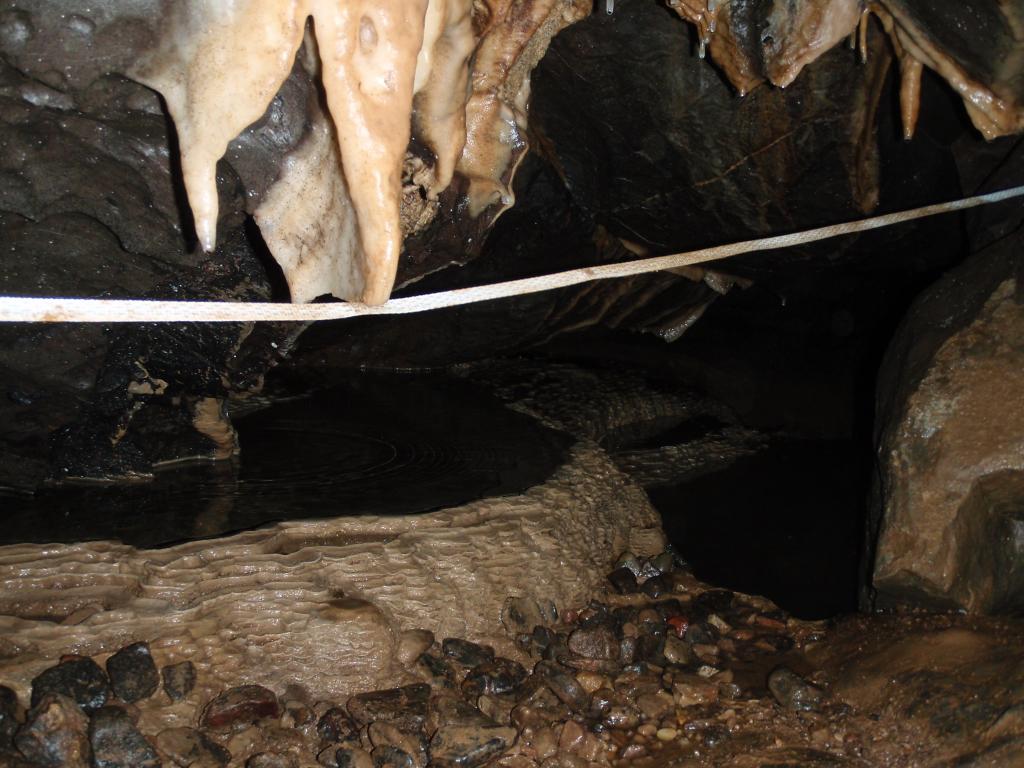
Gour pools in Withyhill Cave, Mendip Hills.
History of recording hypogean Crustacea
In 1812 a blind shrimp was collected from a newly sunk well in the square of St. Bartholomew’s Hospital, London and was named Gammarus subterraneus by Leach in the Edinburgh Encyclopaedia (Leach, 1814). This is the first published record of a hypogean crustacean from Britain. In 1853 Westwood recorded Niphargus stygius from a well near Maidenhead, Berkshire. Hogan (1859) suggests that these two records were in fact Niphargus aquilex. In the middle and later decades of the 19th century naturalists discovered more of these colourless and eyeless shrimps. These initial discoveries were made in water pumped from wells and hence the animals acquired the name “well shrimps”.
The first Irish “well shrimp”, Niphargus irlandicus was collected from an old well sunk in limestone in Dublin in 1863 by Professor Kinahan.
New British species continued to be discovered throughout the early 20th century, including Proasellus cavaticus in 1925 and Bathynella natans (Antrobathynella stammeri) in 1927. From the late 1930s until the 60s a large amount of biological recording was carried out in caves by the Cave Research Group. The two main people involved in this were Brigadier Aubrey Glennie and Mary Hazelton. Hazelton published a series of biological records from caves in 16 parts between 1955 and 1978, which included many records of hypogean Crustacea. Terry Gledhill of the Freshwater Biological Association (FBA) carried out work in Dorset during the late 60s and early 70s, including a long-term study at the Waterston cress beds, which yielded many interesting records
There was then a lull in recording until the late 90s when interest in the group was renewed and the hypogean Crustacea recording scheme was started. Within the last two decades there have been several new developments, with important work being carried out by Paul Wood of Loughborough University in the Peak-Speedwell cave system in the Peak District and on the Little Stour, Kent; interesting records from boreholes by the staff of the Three Valleys Water Company; systematic surveys of groundwater fauna in Ireland by Dr Arnscheidt of Ulster University and L. Knight; and on-going recording from caves and other groundwater habitats across the UK and Ireland by the hypogean Crustacea scheme recorder and others. The work in Ireland led to the discovery of Microniphargus leruthi in 2006, with its subsequent discovery in England in 2010 and Wales in 2011. Bernd Hänfling of Hull University, along with Graham Proudlove, the biological recorder for the British Cave Research Association (BCRA) and others carried out a study of the phylogenetic history and phylogeography of the British and Irish hypogean Crustacea with some interesting results already published (Hänfling et al., 2008; McInerney et al. 2014). Towards the end of the first decade of the 21st century, the Environment Agency began to show an interest in groundwater fauna, leading to the compilation of a review of the sub-surface aquatic ecology of England and Wales (Robertson et al., 2009). Some interesting studies of the hyporheic zone have been carried out by students at Loughborough and Roehampton universities in recent years and there is now an active research community established in Britain dedicated to the study of this ecotone (the Hyporheic Network). The Esmée Fairbarn Foundation funded a project from 2009 to 2011 examining the stygobitic fauna of Devon and Dorset and across the glacial divide in the north-east of England (Groundwater Animals UK project). For several years after this, the British Geological Survey continued to carry out on-going groundwater ecology survey work using its network of monitoring boreholes across the UK which has produced many new records and is likely to produce further interesting results in the future.
The first attempt to describe the distribution of the British hypogean Crustacea was undertaken by Glennie in 1956, which he further expanded in a later publication in 1967. An up-dated review was published in Cave & Karst Science in 2003 by Proudlove et. al. The 2009 EA review adds further information, although it does not concentrate solely on the subterranean Crustacea.